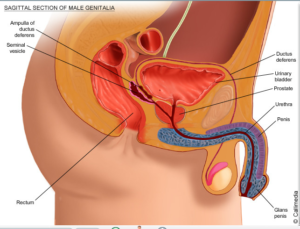Get Care
Azoospermia
Azoospermia
Source: Urology Health, American Urological Association
Male infertility is any health issue in a man that lowers the chances of his female partner getting pregnant.
About 13 out of 100 couples can’t get pregnant with unprotected sex. There are many causes for infertility in men and women. In over a third of infertility cases, the problem is with the man. This is most often due to problems with his sperm production or with sperm delivery.
What Happens Under Normal Conditions?
The man’s body makes tiny cells called sperm. During sex, ejaculation normally delivers the sperm into the woman’s body.
Treatment
If your semen lacks sperm (azoospermia) because of a blockage, there are many surgical choices.
Even men who have low sperm production as a cause of no sperm in the ejaculate can be treated with surgery to find sperm, together with assisted reproduction, since several million sperm have to be made in the testicles before sperm survive to make it into the semen.
Microsurgical Vasovasostomy
Vasovasostomy is used to undo a vasectomy. It uses microsurgery to join the 2 cut parts of the vas deferens in each testicle.
Vasoepididymostomy
Vasoepididymostomy joins the upper end of the vas deferens to the epididymis. It’s the most common microsurgical method to treat epididymal blocks.
Transurethral Resection of the Ejaculatory Duct (TURED)
Ejaculatory duct blockage can be treated surgically. A cystoscope is passed into the urethra (the tube inside the penis) and a small incision is made in the ejaculatory duct. This gets sperm into the semen in about 65 out of 100 men. But there can be problems. Blockages could come back. Incontinence and retrograde ejaculation from bladder damage are other possible but rare problems. Also, only 1 in 4 couples get pregnant naturally after this treatment.

Assisted Reproductive Techniques
If infertility treatment fails or isn’t available, there are ways to get pregnant without sex. These methods are called assisted reproductive techniques (ARTs). Based on the specific type of infertility and the cause, your health care provider may suggest:
In Vitro Fertilization (IVF). IVF is when the egg of a female partner or donor is joined with sperm in a lab Petri dish. For IVF, the ovaries must be stimulated to produce multiple eggs (ova). This is often done with medications given as daily injections. It allows many mature eggs to be retrieved. After 3 to 5 days of growth, the fertilized egg (embryo) is put back into the uterus. IVF can be used to treat many hormone conditions in women, for women with blocked tubes, or idiopathic infertility (where there is no cause that explains the fertility problem). But it’s being used more and more in cases where the man has very severe and untreatable oligospermia (low sperm count).
Intracytoplasmic Sperm Injection (ICSI). ICSI is a variation of IVF. It has revolutionized treatment of severe male infertility. It lets couples thought infertile get pregnant. A single sperm is injected into the egg with a tiny needle. Once the egg is fertilized, it’s put in the female partner’s uterus. Your health care provider may use ICSI if you have very poor semen quality. It is also used if you have no sperm in the semen caused by a block or testicular failure that can’t be fixed. Sperm may also be taken from the testicles or epididymis by surgery for this method.
Sperm Retrieval for ART. Many microsurgical methods can remove sperm blocked by obstructive azoospermia (no sperm). The goal is to get the best quality and number of cells. This is done while trying not to harm the reproductive tract. These methods include:
- TEsticular Sperm Extraction (TESE). This is a common technique used to diagnose the cause of azoospermia. It also gets enough tissue for sperm extraction. The sperm taken from the testicle can be used fresh or frozen (“cryopreserved”). One or many small biopsies are done, often in the office.
- MicroTESE: A more refined form of TESE, where an operating microscope is used to identify small areas of sperm production in the testicles of men who have such low sperm production that no sperm survive to make it into semen.
- TEsticular Sperm Aspiration (TESA). A needle and syringe puncture the scrotal skin to pull sperm from the testicle.
- Percutaneous Epididymal Sperm Aspiration (PESA).PESA may be performed under local or general anesthesia. The urologist sticks a needle attached to a syringe into the epididymis. Then he or she gently withdraws fluid. Sperm may not always be gotten this way. You may still need open surgery.
- Microsurgical Epididymal Sperm Aspiration (MESA). With MESA, sperm are also retrieved from the epididymal tubes. This method uses a surgical microscope. MESA yields high amounts of motile sperm. They can be frozen and thawed later for IVF treatments. This method limits harm to the epididymis.
